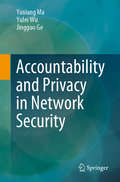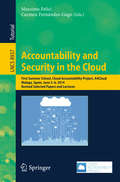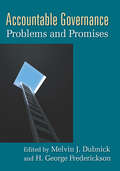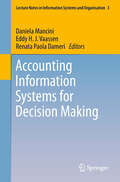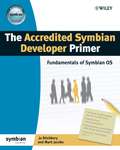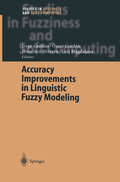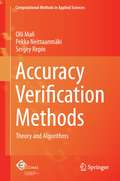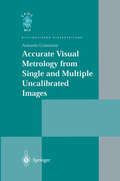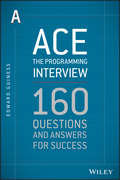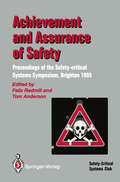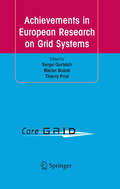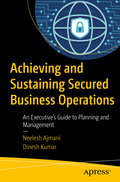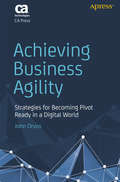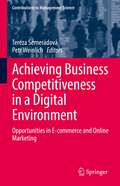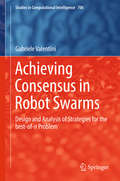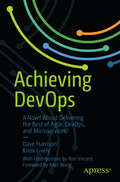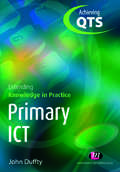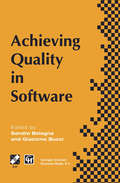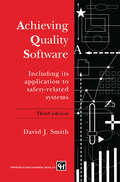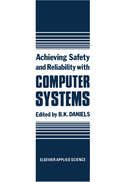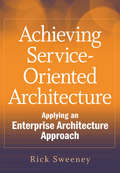- Table View
- List View
Accountability and Privacy in Network Security
by Yuxiang Ma Yulei Wu Jingguo GeThis book discusses accountability and privacy in network security from a technical perspective, providing a comprehensive overview of the latest research, as well as the current challenges and open issues. Further, it proposes a set of new and innovative solutions to balance privacy and accountability in networks in terms of their content, flow and service, using practical deep learning techniques for encrypted traffic analysis and focusing on the application of new technologies and concepts. These solutions take into account various key components (e.g. the in-network cache) in network architectures and adopt the emerging blockchain technique to ensure the security and scalability of the proposed architectures. In addition, the book examines in detail related studies on accountability and privacy, and validates the architectures using real-world datasets. Presenting secure and scalable solutions that can detect malicious behaviors in the network in a timely manner without compromising user privacy, the book offers a valuable resource for undergraduate and graduate students, researchers, and engineers working in the fields of network architecture and cybersecurity.
Accountability and Security in the Cloud: First Summer School, Cloud Accountability Project, A4Cloud, Malaga, Spain, June 2-6, 2014, Revised Selected Papers and Lectures (Lecture Notes in Computer Science #8937)
by Massimo Felici Carmen Fernández-GagoThe First A4Cloud Summer School has been one of the first events in the area of accountability and security in the cloud. It was organized by the EU-funded A4Cloud project, in collaboration with the European projects CIRRUS, Coco Cloud, CUMULUS, and SPECS. Cloud computing is a key technology that is being adopted progressively by companies and users across different application domains and industries. Yet, there are emerging issues such as security, privacy, and data protection. The 13 contributions included in this volume cover the state of the art and provide research insights into the following topics: accountability in the cloud; privacy and transparency in the cloud; empirical approaches for the cloud; socio-legal aspects of the cloud; cloud standards; and the accountability glossary of terms and definitions.
Accountable Governance: Problems and Promises
by Melvin J. Dubnick H. George FredericksonPublic accountability is a hallmark of modern democratic governance and the foundation of the popular performance management movement. Democracy is just an empty exercise if those in power cannot be held accountable in public for their acts and omissions, for their decisions, their policies, and their expenditures. This book offers a finely detailed and richly informed consideration of accountability in both government and the contemporary world of governance. Twenty-five leading experts cover varying aspects of the accountability movement, including multiple and competing accountabilities, measuring accountability, accountability and democratic legitimacy, and accountability and information technology, and apply them to governments, quasi-governments, non-government organizations, governance organizations, and voluntary organizations. Together they provide the most comprehensive consideration of accountability currently available, with a blend of theoretical, empirical, and applied approaches.
Accountable Governance: Problems and Promises
by Melvin J. Dubnick H. George Frederickson David MathewsPublic accountability is a hallmark of modern democratic governance and the foundation of the popular performance management movement. Democracy is just an empty exercise if those in power cannot be held accountable in public for their acts and omissions, for their decisions, their policies, and their expenditures. This book offers a finely detailed and richly informed consideration of accountability in both government and the contemporary world of governance. Twenty-five leading experts cover varying aspects of the accountability movement, including multiple and competing accountabilities, measuring accountability, accountability and democratic legitimacy, and accountability and information technology, and apply them to governments, quasi-governments, non-government organizations, governance organizations, and voluntary organizations. Together they provide the most comprehensive consideration of accountability currently available, with a blend of theoretical, empirical, and applied approaches.
Accounting Information Systems for Decision Making (Lecture Notes in Information Systems and Organisation #3)
by Daniela Mancini, Eddy H. J. Vaassen and Renata Paola DameriThis book contains a collection of research papers on accounting information systems including their strategic role in decision processes, within and between companies. An accounting system is a complex system composed of a mix of strictly interrelated elements such as data, information, human resources, IT tool, accounting models and procedures. Accounting information systems are often considered the instrument by default for accounting automation. This book aims to sketch a clear picture of the current state of AIS research, including design, acceptance and reliance, value-added decision making, interorganizational links, and process improvements. The contributions in this volume emphasize that AIS has grown into a powerful strategic tool. The book provides evidence for this observation by examining a wide range of current issues ranging from theory development in AIS to practical applications of accounting information systems. In particular it focuses on themes of growing interest in the realm of XBRL and Financial Reporting, Management Information Systems, IT/IS Audit and IT/IS Compliance. The book will be of interest to financial and managerial accountants and IT/IS practitioners, including information systems managers and consultants.
The Accredited Symbian Developer Primer: Fundamentals of Symbian OS (Symbian Press #17)
by Jo Stichbury Mark JacobsThis new book, first in the Academy series, is the official guide to the ASD exam, priming candidates for the exam, explaining exactly what they need to know. The Primer explains the knowledge tested in the Accredited Symbian Developer exam, identifying and explaining the topics examined. Each of the exam's objectives is succinctly described, with the appropriate concepts explained in detail. Both standard C++ and topics specific to Symbian C++, such as Symbian Types and Declarations, Platform Secuirty, and Cleanup Stack, are covered. The authors are experts in the field of Symbian C++ and contributed extensively to the design and creation of questions for the ASD exam. Jo Stichbury is the author of Symbian OS Explained and both authors are, of course, fully qualified Accredited Symbian Developers.
Accuracy and Fuzziness. A Life in Science and Politics: A Festschrift book to Enric Trillas Ruiz (Studies in Fuzziness and Soft Computing #323)
by Luis Argüelles MéndezThis book, which goes far beyond a traditional collection of technical articles, is dedicated to Enric Trillas, a fuzzy systems pioneer but also an internationally renowned researcher in other areas of science, such as mathematics and aerospace, and an outstanding manager of scientific affairs in Spain. Some of the contributions in this book develop technical, state-of-the-art themes obviously related to fuzzy logic, while others resemble popular-science articles that shed light on complex mathematical concepts. There are also chapters that highlight the authors’ personal relationships and experiences working with Enric Trillas. While planning this book project, the editors decided to give contributors absolute freedom of thought and expression in preparing their chapters. The result is a colorful and inspiring mixture of styles and topics, which perfectly reflects Enric Trillas’s multifaceted contributions to research and his outstanding role in promoting education and technological transfer in the field of soft computing. This Festschrift to Enric Trillas, published on the occasion of his 75th birthday, is not only intended as an exemplary source of information for young scientists dealing with uncertainty, imprecision and accuracy of models, but also as an inspiring guide to the role of scientists in education, politics and communication.
Accuracy Improvements in Linguistic Fuzzy Modeling (Studies in Fuzziness and Soft Computing #129)
by Francisco Herrera Triguero Luis Magdalena Jorge Casillas O. CordónFuzzy modeling usually comes with two contradictory requirements: interpretability, which is the capability to express the real system behavior in a comprehensible way, and accuracy, which is the capability to faithfully represent the real system. In this framework, one of the most important areas is linguistic fuzzy modeling, where the legibility of the obtained model is the main objective. This task is usually developed by means of linguistic (Mamdani) fuzzy rule-based systems. An active research area is oriented towards the use of new techniques and structures to extend the classical, rigid linguistic fuzzy modeling with the main aim of increasing its precision degree. Traditionally, this accuracy improvement has been carried out without considering the corresponding interpretability loss. Currently, new trends have been proposed trying to preserve the linguistic fuzzy model description power during the optimization process. Written by leading experts in the field, this volume collects some representative researcher that pursue this approach.
Accuracy Verification Methods: Theory and Algorithms (Computational Methods in Applied Sciences #32)
by Olli Mali Pekka Neittaanmäki Sergey RepinThe importance of accuracy verification methods was understood at the very beginning of the development of numerical analysis. Recent decades have seen a rapid growth of results related to adaptive numerical methods and a posteriori estimates. However, in this important area there often exists a noticeable gap between mathematicians creating the theory and researchers developing applied algorithms that could be used in engineering and scientific computations for guaranteed and efficient error control. The goals of the book are to (1) give a transparent explanation of the underlying mathematical theory in a style accessible not only to advanced numerical analysts but also to engineers and students; (2) present detailed step-by-step algorithms that follow from a theory; (3) discuss their advantages and drawbacks, areas of applicability, give recommendations and examples.
Accurate Layer Selections Using Photoshop’s Selection Tools: Use Photoshop and Illustrator to Refine Your Artwork
by Jennifer HarderTake your hand-drawn illustrations to the next level by using various selection tools in Photoshop to clean up the artwork, and Illustrator for final refinement. Also, learn to save your artwork as vector images to be used for web, print, or even stills for character animation. Author Jennifer Harder begins by showing you how to use basic tools in Photoshop to clean up your artwork, followed by Marquee tools and more. Next, you will see how to use more advanced tools such as Lasso, Magic Wand, the Object Selection tool, and so on. You’ll then get a demonstration of how to control the type of selection using the selection main menu, how to copy selections to another layer, and how to use the focus area. This is followed by a chapter that covers paths, channels, and layer masks that you will master to clean up your artwork. To round things out, you will learn how to use Illustrator’s different features to further enhance your work. On completing the book, you will have mastered how to make your artwork and illustrations portfolio-ready. What You Will LearnMaster each selection tool found in PhotoshopChoose the right tools for cleaning and refining artworkSave selections for other projectsMake your artwork scalable in Illustrator using various methods Who Is This Book For Readers with little-to-intermediate-level experience with Photoshop.
Accurate Visual Metrology from Single and Multiple Uncalibrated Images (Distinguished Dissertations)
by Antonio CriminisiAccurate Visual Metrology from Single and Multiple Uncalibrated Images presents novel techniques for constructing three-dimensional models from bi-dimensional images using virtual reality tools. Antonio Criminisi develops the mathematical theory of computing world measurements from single images, and builds up a hierarchy of novel, flexible techniques to make measurements and reconstruct three-dimensional scenes from uncalibrated images, paying particular attention to the accuracy of the reconstruction.This book includes examples of interesting viable applications (eg. Forensic Science, History of Art, Virtual Reality, Architectural and indoor measurements), presented in a simple way, accompanied by pictures, diagrams and plenty of worked examples to help the reader understand and implement the algorithms.
Ace the Programming Interview: 160 Questions and Answers for Success
by Edward GuinessBe prepared to answer the most relevant interview questions and land the job Programmers are in demand, but to land the job, you must demonstrate knowledge of those things expected by today's employers. This guide sets you up for success. Not only does it provide 160 of the most commonly asked interview questions and model answers, but it also offers insight into the context and motivation of hiring managers in today's marketplace. Written by a veteran hiring manager, this book is a comprehensive guide for experienced and first-time programmers alike. Provides insight into what drives the recruitment process and how hiring managers think Covers both practical knowledge and recommendations for handling the interview process Features 160 actual interview questions, including some related to code samples that are available for download on a companion website Includes information on landing an interview, preparing a cheat-sheet for a phone interview, how to demonstrate your programming wisdom, and more Ace the Programming Interview, like the earlier Wiley bestseller Programming Interviews Exposed, helps you approach the job interview with the confidence that comes from being prepared.
Ace the Programming Interview: 160 Questions and Answers for Success
by Edward GuinessBe prepared to answer the most relevant interview questions and land the job Programmers are in demand, but to land the job, you must demonstrate knowledge of those things expected by today's employers. This guide sets you up for success. Not only does it provide 160 of the most commonly asked interview questions and model answers, but it also offers insight into the context and motivation of hiring managers in today's marketplace. Written by a veteran hiring manager, this book is a comprehensive guide for experienced and first-time programmers alike. Provides insight into what drives the recruitment process and how hiring managers think Covers both practical knowledge and recommendations for handling the interview process Features 160 actual interview questions, including some related to code samples that are available for download on a companion website Includes information on landing an interview, preparing a cheat-sheet for a phone interview, how to demonstrate your programming wisdom, and more Ace the Programming Interview, like the earlier Wiley bestseller Programming Interviews Exposed, helps you approach the job interview with the confidence that comes from being prepared.
Achievement and Assurance of Safety: Proceedings of the Third Safety-critical Systems Symposium
by Felix Redmill Tom AndersonEach year there are improvements in safety-critical system technology. These arise both from developments in the contributing technologies, such as safety engineering, software engineering, human factors and risk assessment, and from the adoption or adaptation of appropriate techniques from other domains, such as security. For these improvements to be of real benefit, they need to be applied during the appropriate stage in the life cycle of the system, whether it be development, assessment, or operation. For this to occur, they must be communicated and explained. Each year the Safety-critical Systems Symposium offers a distinguished forum for the presentation of papers on such developments, and also for papers from industry on the lessons learned from the use of technologies and methods. The results of many collaborative research projects, with components from both industry and academia, are reported in a universally understandable form. In 1995 the Symposium was held in Brighton, a venue calculated to stimulate not just the presenters of papers, but all the delegates. Yet, this book of Proceedings is intended not only for the delegates but also for readers not able to attend the event itself. We welcome both categories of reader. Delegates have the benefit of attending the presentations and the opportunity to participate in the discussions; those who take up this book after the event can peruse it attheir leisure and, perhaps, on account of it will resolve to attend subsequent symposia.
Achievements in European Research on Grid Systems: CoreGRID Integration Workshop 2006 (Selected Papers)
by Sergei Gorlatch Marian Bubak Thierry PriolThis volume comprises the edited proceedings of the second CoreGRID Integration Workshop, CGIW'2006, held October 2006 in Krakow, Poland. A "Network of Excellence" funded by the European Commission’s Sixth Framework Program, CoreGRID aims to strengthen and advance scientific and technological excellence in the area of Grid and Peer-to-Peer technologies by bringing together a critical mass of well-established researchers from 41 European research institutions. Designed for a professional audience of industry practitioners and researchers, the volume is also suitable for advanced-level students in computer science.
Achieving and Sustaining Secured Business Operations: An Executive’s Guide to Planning and Management
by Neelesh Ajmani Dinesh KumarProactively plan and manage innovation in your business while keeping operations safe and secure. This book provides a framework and practices to help you safeguard customer information, prevent unauthorized access, and protect your brand and assets.Securing company operations is a board-level discussion. Across all industries, companies are pouring millions of dollars into taming cybercrime and other related security crime. Achieving and Sustaining Secured Business Operations presents a holistic approach looking top down, bottom up, and sideways. The end goal is to achieve and sustain a safe environment to conduct secured business operations while continuously innovating for competitive advantage.What You’ll LearnDiscover why security, specifically secured business operations, needs to be part of business planning and oversight by design and not left to technologists to make the business caseDetermine what you can do in your role and in your organization to drive and implement integration and improvements in planning and managing secured business operations in conjunction with other business planning and management activitiesChoose ways in which progress toward achieving and sustaining secured business operations can be measuredUnderstand best practices for organizing, planning, architecting, governing, monitoring, and managing secured business operationsCreate a framework, including methods and tools for operationalizing assessment, planning, and ongoing management of secured business operationsUse cases and potential case studies for various industries and business models Who This Book Is For Chief executive officers and their leadership team; chief operations officers; chief information officers and their leadership team; chief information security officers; business functional middle managers; and enterprise, solution, and information technology architects
Achieving Business Agility: Strategies for Becoming Pivot Ready in a Digital World
by John OrvosKnow how to lead and establish business agility in your organization. Benefit from clear, actionable steps based on change management truths that have been long underutilized and have limited the success of agile expansion into your business. This book provides a pragmatic framework for leading your business toward shifting to an agile mindset. Achieving Business Agility offers strategies and concrete examples to engage business executives and will teach you how to effectively execute these strategies. Whether you are a delivery executive, a change advocate, a consultant, a business leader, or a newcomer to agile, you will learn clear actions from a practical, business-oriented perspective that is vital to effect change and bring agile into your business. The book is structured in three sections. The first provides you with a deep understanding of each of four strategies. The second section tells the story of a company that applied these strategies through the eyes of several key players. The last section helps you get started applying what you learned in your own company. What You’ll Learn Get the attention of your executives by alerting them to a company problem that can impact them personally and create a sense of urgency to address itCollaborate with your executives in a way that gets them to open up and to see how their operating model is a contributing cause to the company problemDemonstrate how your executives can specifically benefit from a new agile business operating model and address the company problemCreate a reinforcement structure on a larger scale to establish agile as the new standard operating model in your organization Who This Book Is For Managers, business leaders, and consultants at/for large enterprises or small startups who want their company to better compete in today’s fast-moving markets that present threats and opportunities at every turn. No agile expertise is required.
Achieving Business Competitiveness in a Digital Environment: Opportunities in E-commerce and Online Marketing (Contributions to Management Science)
by Tereza Semerádová Petr WeinlichThe COVID-19 pandemic has been a very strong reminder that the future economic development of any country is more than ever influenced by its ability to ramp-up digital competitiveness. Consequently, enterprises were pushed to assess and develop the possibilities offered by e-commerce and online marketing tools. In this book, experts outline the prerequisites for such online marketing competitiveness and compare the current level of digital marketing competitiveness in Europe by using publicly available macro and micro-level data. The authors present their analyses and recommendations including interviews with over 125 online marketers and e-commerce specialists and present the lessons from digitalization of over 600 SMEs.
Achieving Consensus in Robot Swarms: Design and Analysis of Strategies for the best-of-n Problem (Studies in Computational Intelligence #706)
by Gabriele ValentiniThis book focuses on the design and analysis of collective decision-making strategies for the best-of-n problem. After providing a formalization of the structure of the best-of-n problem supported by a comprehensive survey of the swarm robotics literature, it introduces the functioning of a collective decision-making strategy and identifies a set of mechanisms that are essential for a strategy to solve the best-of-n problem. The best-of-n problem is an abstraction that captures the frequent requirement of a robot swarm to choose one option from of a finite set when optimizing benefits and costs. The book leverages the identification of these mechanisms to develop a modular and model-driven methodology to design collective decision-making strategies and to analyze their performance at different level of abstractions. Lastly, the author provides a series of case studies in which the proposed methodology is used to design different strategies, using robot experiments to show how the designed strategies can be ported to different application scenarios.
Achieving DevOps: A Novel About Delivering the Best of Agile, DevOps, and Microservices
by Dave Harrison Knox LivelyBen is stuck. A development lead with a strong vision for how the intersection of development and operations at his office can be improved, he can’t help but feel overwhelmed and discouraged by common problems such as slow turnaround time, rushed and ineffective handover documentation, mounting technical debt, and a lagging QA process. What steps should Ben take to build the momentum needed to create positive changes within his company? In this unique business novel by Dave Harrison and Knox Lively, two DevOps professionals with years of diverse experience in the industry, you follow Ben as he solves work frustrations in order to adopt Agile, DevOps, and microservices architectures for his organization. Achieving DevOps addresses the “Now what?” moment many DevOps professionals face on their journey. The story provides you with the knowledge you need to navigate the internal political waters, build management support, show measurable results, and bring DevOps successfully into your organization.Come away with practical lessons and timeless business concepts. You’ll know how to effect change in a company from the bottom up, gain support, and instill a pattern of progressively building on success. Experience Ben’s progress vicariously in Achieving DevOps and bridge the gap between inspiration and the implementation of your own DevOps practices.Who This Book Is ForThose serving as change agents who are working to influence and move their organizations toward a DevOps approach to software development and deployment: those working to effect change from the bottom up such as development leads, QA leads, project managers, and individual developers; and IT directors, CTOs, and others at the top of an organization who are being asked to lend their support toward DevOps implementation efforts
Achieving QTS Extending Knowledge in Practice
by John DufftyStill the biggest concern for many on initial teacher training courses is the acquisition of subject knowledge and the ability to translate that into effective teaching. This book addresses this - building on the core subject knowledge covered in the Achieving QTS series and relating it to classroom practice. It supports trainees in extending and deepening their knowledge of ICT and demonstrating how to apply it to planning and implementing lessons. Practical and up-to-date teaching examples are used to clearly contextualize subject knowledge. A clear focus on classroom practice helps trainees to build confidence and develop their own teaching strategies.
Achieving Quality in Software: Proceedings of the third international conference on achieving quality in software, 1996 (IFIP Advances in Information and Communication Technology)
by S. Bologna G. BucciSoftware quality is a generalised statement difficult to agree or disagree with until a precise definition of the concept of "Software Quality" is reached in terms of measurable quantities. Unfortunately, for the software technology the basic question of: • what to measure; • how to measure; • when to measure; • how to deal with the data obtained are still unanswered and are also closely dependant on the field of application. In the past twenty years or more there have been a number of conferences and debates focusing on the concept of Software Quality, which produced no real industrial impact. Recently, however, the implementation of a few generic standards (ISO 9000, IEEE etc.) has produced and improved application of good practice principles at the industrial level. As a graduate in PhYSiCS, I still believe it is a long way before the concept of Software Quality can be defined exactly and measured, if ever. This is way I think the AQuIS series of conferences is important, its object begin to provide a platform for the transfer of technology and know how between Academic, Industrial and Research Institutions, in the field of Software Quality. Their objects are: • to provide a forum for the introduction and discussion of new research breakthroughs in Software Quality; • to provide professional Software Quality engineers with the necessary exposure to the results of current research; • to expose the research community to the problems of practical application of new results.
Achieving Quality Software: Including Its Application to Safety-Related Systems
by D.J. SmithThe rapid growth in use of programmable technology, in nearly all sectors of Engineering, is a well-known established trend and one which there is every reason to believe will continue into the foreseeable future. The drivers of this trend include cost, flexibility, rich functionality and certain reliability and safety advantages. However, as explained in this book, these advantages have to be carefully weighed against a number of dis advantages which, amongst other things, have fundamental implications for reliability and safety. Ideally, a programmable system would be viewed as a fusion of hardware, software and user (or 'skinware'), operating under a set of environmental conditions. To date, such a unifying model does not exist and so hardware, software and human factors are still considered largely as three separate disciplines, albeit with certain interdependencies. Established techniques are available which enable the engineer to develop systems comprising purely hardware components to a prescribed reliability and performance. Software, however, is fundamentally different in a number of ways, and does not lend itself to equivalent analysis. A major problem with software is its poor 'visibility', and consequently the great difficulty in understanding and predicting its behaviour in all cir cumstances. This results in the ever-present software design flaws, or 'bugs', which have plagued the software industry from its beginnings.
Achieving Safety and Reliability with Computer Systems
by B. K. DanielsThe safe operation of computer systems, in both their software and hardware continues to be a key issue in many real time applications, when people, environment, investment or goodwill can be at risk. Such applications include the monitoring and control of high energy processes, of nuclear and chemical plants, of factory automation, of transportation systems, or funds transfer and of communication and information systems. This book represents the proceedings of the 1987 Safety and Reliability Society Symposium held in Altrincham, UK, 11-12 November 1987. It is thus part of the series of proceedings for Society Events, which in previous years have not addressed the topic of the Safety and Reliability of Computer Systems. The book is also part of another series of reports, and is closely related to the Elsevier Book "Safety and Reliability of Programmable Electronic Systems" which I edited in 1986, and the series of workshops known as SAFECOMP held in 1979, 1982, 1983, 1985, 1986 which are referenced in some of the papers. The structure of the book represents the structure of the Symposium itself. The session titles, and the papers as selected represent the current practice in many industries. The trend is towards more industrial usage of Formal Methods, and tools to support these methods, whilst continuing to make best use of Software Engineering, Safety and Reliability Assessment, and accumulated experience.
Achieving Service-Oriented Architecture: Applying an Enterprise Architecture Approach
by Rick SweeneyA complete, comprehensive methodology and framework for adopting and managing a successful service oriented architecture environment Achieving Service-Oriented Architecture helps to set up an SOA Architecture Practice defining the policies, procedures, and standards that apply not just to IT developers but to the entire corporation as it relates to business applications. Why a new architectural approach is necessary for your business to achieve all the value SOA has to offer Focuses on setting up an enterprise architecture practice for service-oriented architecture Discusses the implementation and governance processes for SOA Defines and describes an overall architectural framework for managing SOA assets at an enterprise architecture level Shows how to set up and run an SOA Enterprise Architecture Practice using the methodology and framework presented Defining how an Architecture Practice can transform itself and your corporation to maximize the benefits of the SOA approach, Achieving Service-Oriented Architecture provides a pragmatic enterprise architecture approach and framework for implementing and managing service oriented architecture from a business organization and business practices perspective. Note: CD-ROM/DVD and other supplementary materials are not included as part of eBook file.
